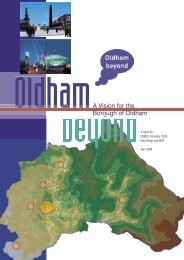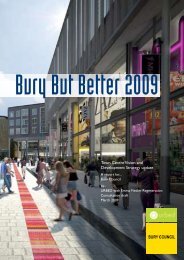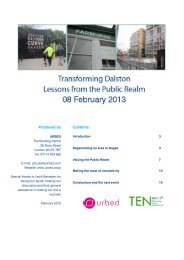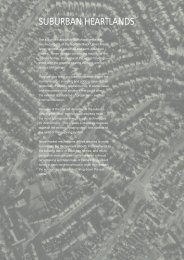A Better Way to Recycle: co-operative and community ... - Urbed
A Better Way to Recycle: co-operative and community ... - Urbed
A Better Way to Recycle: co-operative and community ... - Urbed
You also want an ePaper? Increase the reach of your titles
YUMPU automatically turns print PDFs into web optimized ePapers that Google loves.
2. The waste problemthe <strong>to</strong>tal waste, whilst <strong>co</strong>mmerce ac<strong>co</strong>unted for25 million <strong>to</strong>nnes. These are the most recentfigures obtained from a survey carried out bythe Environment Agency of around 20,000industrial <strong>and</strong> <strong>co</strong>mmercial businesses in 1998/9.The Environment Agency is currently carryingout a se<strong>co</strong>nd survey <strong>and</strong> the results areexpected soon.The main industrial waste stream (25%) ismineral waste <strong>and</strong> residues, with a further 20%of general industrial waste. The individual sec<strong>to</strong>rthat produced the most waste was the basicmetals sec<strong>to</strong>r with nine million <strong>to</strong>nnes (31% ofwaste was l<strong>and</strong>filled, 31% re-used <strong>and</strong> 34%recycled). The food, drink <strong>and</strong> <strong>to</strong>bac<strong>co</strong> industrysec<strong>to</strong>r produced just over seven million <strong>to</strong>nnes(35% was l<strong>and</strong>filled, 17% re-used <strong>and</strong> 26%recycled) <strong>and</strong> the utilities industry sec<strong>to</strong>rproduced just under seven million <strong>to</strong>nnes (49%was l<strong>and</strong>filled, 49% recycled <strong>and</strong> only 0.4% reused).These figures show that there is a lot ofpotential for increasing re-use <strong>and</strong> recyclingrates, <strong>and</strong> increasing legislation <strong>and</strong> reducedl<strong>and</strong>fill space means that industry needs <strong>to</strong> findalternatives <strong>to</strong> the traditional wastemanagement option of l<strong>and</strong>fill. This is madeeven more urgent by the reclassification ofsome waste streams through theimplementation of the Hazardous WasteRegulations 2005 <strong>and</strong> the limitations on theacceptance of such materials at many l<strong>and</strong>fillsites.In the <strong>co</strong>mmercial sec<strong>to</strong>r, waste streams are lessvaried <strong>and</strong> 75% is classified as general<strong>co</strong>mmercial waste with paper <strong>and</strong> card makingup 10%. Retail produces the most waste ataround just under six million <strong>to</strong>nnes (50% ofwaste is l<strong>and</strong>filled, 28% is recycled <strong>and</strong> only 2%is re-used). Travel agents <strong>and</strong> other types ofservice business produce five million <strong>to</strong>nnes ofwaste (59% is l<strong>and</strong>filled, 18% recycled <strong>and</strong> 1%re-used) whilst the hotel <strong>and</strong> catering sec<strong>to</strong>rproduces just under four million <strong>to</strong>nnes of waste(60% of waste is l<strong>and</strong>filled, 15% recycled <strong>and</strong>only 0.9% re-used). With such heavy use of thel<strong>and</strong>filling option, there is a large potential forincreasing re-use <strong>and</strong> recycling rates.Within the individual waste streams, the mostrecycled materials are mineral wastes <strong>and</strong>residue, <strong>and</strong> metals <strong>and</strong> scrap equipment.Mineral wastes <strong>and</strong> residue are also the most reused.The lowest rates of re-use <strong>and</strong> recyclingare for paper <strong>and</strong> card, <strong>and</strong> <strong>co</strong>nstruction <strong>and</strong>demolition wastes.Overall, the re-use <strong>and</strong> recycling rates inindustry <strong>and</strong> <strong>co</strong>mmerce are higher than formunicipal waste, at 44% for the industrial sec<strong>to</strong>r<strong>and</strong> 24% for the <strong>co</strong>mmercial sec<strong>to</strong>r. Thesehigher re<strong>co</strong>very <strong>and</strong> recycling rates can bepartially explained by the increased financialincentives applicable in these sec<strong>to</strong>rs such ashigher l<strong>and</strong>fill <strong>co</strong>sts for hazardous waste <strong>and</strong>also the lack of suitable l<strong>and</strong>fill sites, as well asthe <strong>co</strong>mmercial awareness of the <strong>co</strong>st of waste<strong>and</strong> the potential value that it may have.There are a number of barriers <strong>to</strong> recycling. Forexample, plastic packaging ac<strong>co</strong>unts for 20% ofthe weight of all packaging <strong>and</strong> 53% of allgoods are packaged in plastics. However, only23% of plastic packaging waste was recycled inthe UK in 2001. This is partially because plastichas a high volume <strong>to</strong> weight ratio, which canmake recycling <strong>co</strong>llections of plastic packagingwaste less efficient than the <strong>co</strong>llection of otherrecyclables which weigh more 7 . This isparticularly the case for kerbside <strong>co</strong>llectionsfrom municipal sources. In addition, manyplastics are ‘<strong>co</strong>ntaminated’ with other materialse.g. two plastics in one product (bottles <strong>and</strong>labels made of different types of plastic), or areintrinsically mixed with other materials <strong>to</strong>achieve properties suitable for use e.g. flameretardants in plastic cable <strong>co</strong>atings. This‘<strong>co</strong>ntamination’ can make recycling une<strong>co</strong>nomi<strong>co</strong>r impracticable.The lack of end-markets for mixed <strong>and</strong> singlestream plastics also forms a barrier <strong>to</strong> increasedplastics recycling. This is mainly because thefood packaging industry, the biggest singlemarket for plastics, has been reluctant <strong>to</strong> userecycled plastic because of <strong>co</strong>ncerns about foodsafety. However, a method of addressing thisproblem is by enclosing the recycled plasticbetween layers of virgin plastic <strong>to</strong> ensure thepackaging <strong>co</strong>nforms <strong>to</strong> hygiene st<strong>and</strong>ards.2.4 Construction <strong>and</strong> demolition wasteThe Office of the Deputy Prime Minister(ODPM) estimated that the <strong>co</strong>nstruction <strong>and</strong>demolition waste in Engl<strong>and</strong> <strong>and</strong> Wales was 93.912The National Centre for Business & Sustainability
















